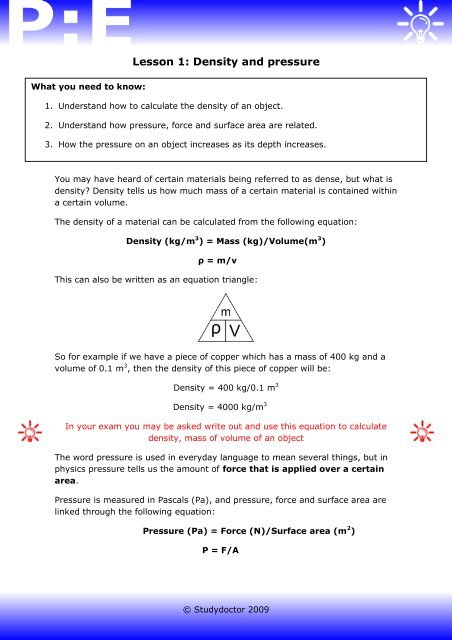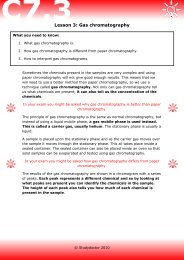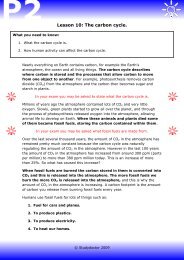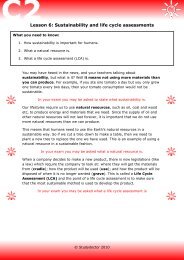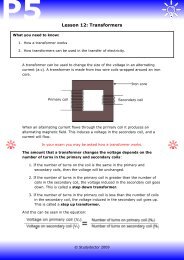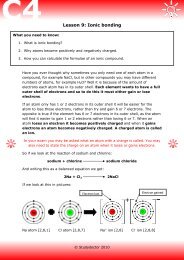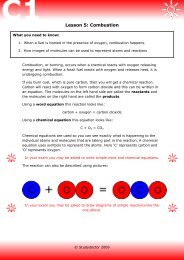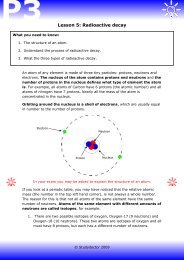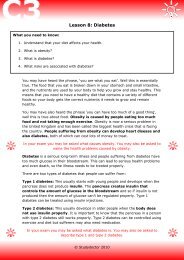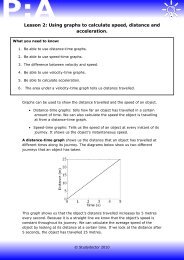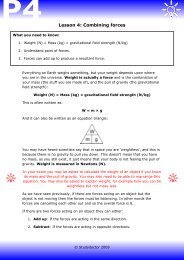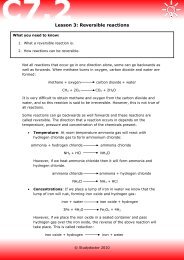Open lesson 1: Density and pressure worksheet
Open lesson 1: Density and pressure worksheet
Open lesson 1: Density and pressure worksheet
Create successful ePaper yourself
Turn your PDF publications into a flip-book with our unique Google optimized e-Paper software.
Lesson 1: <strong>Density</strong> <strong>and</strong> <strong>pressure</strong><br />
What you need to know:<br />
1. Underst<strong>and</strong> how to calculate the density of an object.<br />
2. Underst<strong>and</strong> how <strong>pressure</strong>, force <strong>and</strong> surface area are related.<br />
3. How the <strong>pressure</strong> on an object increases as its depth increases.<br />
You may have heard of certain materials being referred to as dense, but what is<br />
density? <strong>Density</strong> tells us how much mass of a certain material is contained within<br />
a certain volume.<br />
The density of a material can be calculated from the following equation:<br />
<strong>Density</strong> (kg/m 3 ) = Mass (kg)/Volume(m 3 )<br />
ρ = m/v lllll<br />
This can also be written as an equation triangle:<br />
So for example if we have a piece of copper which has a mass of 400 kg <strong>and</strong> a<br />
volume of 0.1 m 3 , then the density of this piece of copper will be:<br />
<strong>Density</strong> = 400 kg/0.1 m 3<br />
<strong>Density</strong> = 4000 kg/m 3 llll<br />
In your exam you may be asked write out <strong>and</strong> use this equation to calculate<br />
density, mass of volume of an object<br />
The word <strong>pressure</strong> is used in everyday language to mean several things, but in<br />
physics <strong>pressure</strong> tells us the amount of force that is applied over a certain<br />
area.<br />
Pressure is measured in Pascals (Pa), <strong>and</strong> <strong>pressure</strong>, force <strong>and</strong> surface area are<br />
linked through the following equation:<br />
Pressure (Pa) = Force (N)/Surface area (m 2 )<br />
P = F/A lllllllllllllllllll<br />
© Studydoctor 2009
This can also be written as an equation triangle:<br />
This means that if we increase the surface area of an object, but keep the force<br />
applied constant, then the <strong>pressure</strong> will decrease.<br />
This is the reason why people who walk across ice wear snow shoes, which have<br />
large surface areas. The increased surface area means that the person produces<br />
a smaller <strong>pressure</strong> on the ice <strong>and</strong> so it is less likely to break. This can be seen in<br />
the example below:<br />
Two people both, with a weight of 1000N are walking across a frozen lake. The<br />
first person is wearing snow shoes which have a surface area of 0.1m 2 <strong>and</strong> the<br />
second person is wearing normal shoes which have a surface area of 0.025m 2 . If<br />
the <strong>pressure</strong> they exert on the ice exceeds 35,000 Pa then the ice will break, so<br />
will the two people be safe? To find out we need to calculate the <strong>pressure</strong> that<br />
each person exerts on the ice:<br />
Person 1:<br />
Person 2:<br />
Pressure = Force/Area<br />
llllllPressure = 1000 N/0.1 m 2<br />
Pressure = 10 000 Palll<br />
Pressure = Force/Area<br />
Lllllll lPressure = 1000 N/0.025 m 2<br />
Pressure = 40 000 Pal l<br />
This means that the second person is exerting a <strong>pressure</strong> greater than 35,000 Pa<br />
<strong>and</strong> so they will fall through the ice! This is why it is important to wear snow<br />
shoes. By increasing the surface area, the person 1 has decreased the <strong>pressure</strong><br />
they exert, even though they have the same mass as person 2.<br />
If the forces applied on objects are the same then the bigger the surface area<br />
the smaller the <strong>pressure</strong> exerted.<br />
In your exam you may be asked to make a similar calculation to the example<br />
above. You may also be asked how surface area can affect <strong>pressure</strong> <strong>and</strong> vice<br />
versa.<br />
© Studydoctor 2009
If you have ever been diving underwater you will know that the deeper you go<br />
underwater, the more <strong>pressure</strong> your body will feel. This is because as you go<br />
deeper down in the water you will have more water above you pushing down<br />
upon your body <strong>and</strong> so your body will feel more <strong>pressure</strong>.<br />
So how can we calculate the increase in <strong>pressure</strong> an object will feel as it goes<br />
deeper underwater? To do this we can use the equation:<br />
Pressure = Force/Area<br />
P = F/A<br />
Firstly we need to calculate the force that the water exerts upon the object that<br />
is underwater:<br />
Force = mass × gravitational field strength<br />
F = m × g<br />
<strong>and</strong> the mass of the water can be calculated from the equation:<br />
Mass = density × volume<br />
m = ρ × v<br />
However since volume = area × height, this equation can be written as<br />
Mass = density × area × height<br />
m = ρ × A × h<br />
This means that the equation for force can be written as:<br />
Force = density × area × height × gravitational field strength<br />
F = ρ × A × h × g<br />
Now to calculate the <strong>pressure</strong> on an object we need to use the equation:<br />
P = F/A<br />
And so inserting our equation for force, then <strong>pressure</strong> an object feels is:<br />
P = (ρ × A × h × g)/A<br />
P = ρ × h × g<br />
Pressure = density × height × gravitational field strength<br />
In your exam you may be asked write out <strong>and</strong> use this equation to calculate how<br />
the <strong>pressure</strong> on an object increases with depth<br />
© Studydoctor 2009
So what is the <strong>pressure</strong> difference a diver will feel as they dive from the waters’<br />
surface to a depth of 10m? Well we can use the equation:<br />
P = ρ × h × g<br />
And since we know that water has a density of 1000 kg/m 3 , the depth of the<br />
diver is 10 m <strong>and</strong> the gravitational field strength is 10 N/kg, then the <strong>pressure</strong><br />
difference is:<br />
P = 1000 kg/m 3 × 10 m × 10 N/kg<br />
P = 100, 000 Pa<br />
This means that the <strong>pressure</strong> on the diver at a depth of 10 m will be 100,000 Pa<br />
greater than at the waters’ surface.<br />
In your exam you may be asked make a similar calculation to work out the<br />
<strong>pressure</strong> difference on an object as it changes depth.<br />
Recap:<br />
1. The density of an object can be calculated from the equation:<br />
<strong>Density</strong> (kg/m 3 ) = Mass (kg)/Volume (m 3 )<br />
2. The <strong>pressure</strong> that an object exerts can be calculated from the equation:<br />
Pressure (Pa) = Force (N)/Surface area (m 2 )<br />
3. If two objects have the same force applied to them, then an object with a large<br />
surface area will exert a smaller <strong>pressure</strong> than an object with a smaller surface area.<br />
4. As an object goes deeper underwater than the <strong>pressure</strong> on it will increase. This can<br />
be calculated from the equation:<br />
Pressure = density × height × gravitational field strength<br />
© Studydoctor 2009


